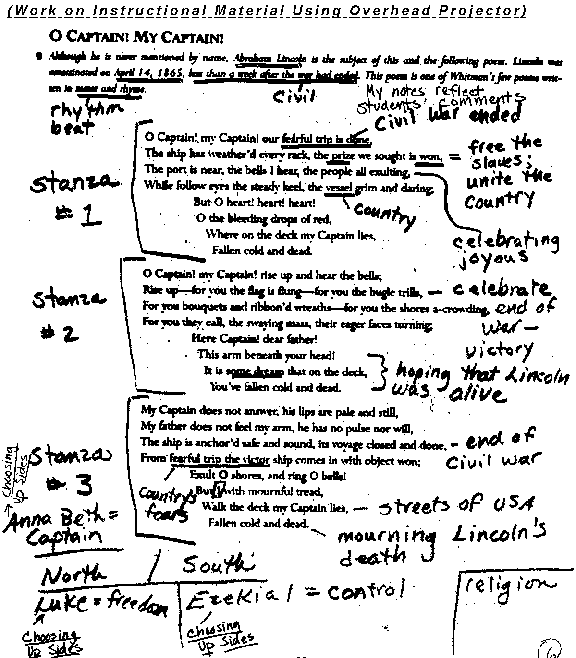

That, friends, is the rhythm of the iamb. Read it out loud, and you should hear da-DUM da-DUM da-DUM.

The same can be said for much, but not all, of this poem. Say the word “belong” out loud (make sure nobody’s looking first). What the heck is that? Well, an iamb is a two-syllable unit in which the first syllable doesn’t get much emphasis, but then the second one does. Mainly, the meter of the poem is in an iambic meter. That choppiness carries over to the meter of the poem, as well. It’s as though his grief is responsible for the interrupted flow of these indented lines. They are shorter, choppier lines in which the speaker is introspective, reflecting on the loss of the captain. Visually, though, these lines of the chorus break off from the narrative, longer lines of the verses. So if you were hearing the poem, you probably wouldn’t know that lines 5 through 8 were shorter than lines 1 through 4. Still, notice how if you treat lines 5 and 6 as one line and 7 and 8 as another line, then the rhyming couplet pattern continues throughout the entire poem. They’re much shorter than the first four-about half as long, actually. The last four lines in each stanza also represent a break in the pattern. The death that is the subject of the poem has upset the order of things, including the very rhymes themselves. It’s a sad song of remembrance, and these slant rhymes are there to remind us that it’s not all high-fives and good times going on here. Sure, it may rhyme some of the time (see what we did there?), but it’s not a happy sing-a-long. Remember that a dirge may be a song, but it’s a song for the dead. Why would Whitman mix up the rhymes this way? It wasn’t that he misplaced his rhyming dictionary. Others like lines 9 and 10 have near, or slant, rhyme (“bells” and “trills”), meaning that the end words rhyme, but not so closely.

Some of the couplets rhyme perfectly, like lines 1 and 2 (“done” and “won”) and lines 17 and 18 (“still” and “will”). The verse sections are rhymed couplets, or two lines that finish with end rhymes and are related in their content. Rhymin’ and Slantin’īroken into three stanzas, each stanza contains a verse (in this case, these are the longer lines describing the arrival of the ship) and a chorus (here, the shorter lines describing the scene of the dead captain and the sailor that loves him). (The dirge eventually evolved into a drinking song, but for our purposes that’s neither here nor there.) Whitman thought of his poems as songs, and “O Captain! My Captain!” is a piece that is closer to a song than any other written by Whitman. But the poetic form came to mean any mournful song for the dead. Yeah, we talked smack about the release order fans in the intro, but don't worry, we've got your back too.The poetic form of the dirge comes out of the early Christian Church when Christians would say morning prayers for, among others, the dead. Despite the quantum shenanigans and weird ways that interacts with time, this one easily slots into the timeline. Cue the whole family suiting up and leading a rebellion against him in order to save the day. Kang wants Ant-Man’s help getting out of the Quantum Realm so he can conquer and destroy even more universes and he’s not above threatening Cassie to do it. It turns out that Janet Van Dyne has been keeping quiet about a whole civilization in the Quantum Realm that’s ruled over by powerful dictator Kang the Conqueror who she accidentally put in power before returning home.


 0 kommentar(er)
0 kommentar(er)
